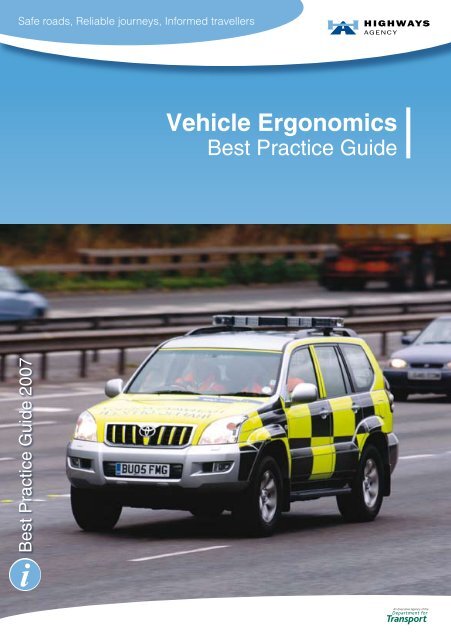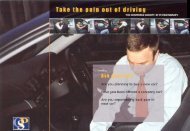Vehicle Ergonomics - Driving Ergonomics - Loughborough University
Vehicle Ergonomics - Driving Ergonomics - Loughborough University
Vehicle Ergonomics - Driving Ergonomics - Loughborough University
Create successful ePaper yourself
Turn your PDF publications into a flip-book with our unique Google optimized e-Paper software.
Best Practice Guide 2007<br />
<strong>Vehicle</strong> <strong>Ergonomics</strong><br />
Best Practice Guide
Introduction<br />
About 80% of us will experience back pain at some stage in our<br />
lives. A number of work and leisure activities can contribute to<br />
back pain, but if you spend long hours driving, you may suffer<br />
from prolonged discomfort or pain in your back.<br />
Sitting in the same position for long hours gripping the steering<br />
wheel and being exposed to vibration from the road can<br />
contribute to the wear and tear on your back, but there are things<br />
you can do to reduce your chances of suffering from back pain.<br />
• Vary your work activities as much as possible during the day.<br />
Swap between the roles of driver and comms officer so that<br />
your posture changes. Try not to keep the same role for more<br />
than four hours.<br />
• Take a break from driving every couple of hours.<br />
• Make sure you get out of the vehicle as often as possible,<br />
move about and carry out small stretches if you can. Do not<br />
carry out any sudden intense physical activity (such as lifting,<br />
bending or stretching) without warming up first.<br />
• Make small adjustments to your driving position every couple<br />
of hours.<br />
• Follow the posture guide on the following pages to make sure<br />
you are sitting correctly.<br />
With thanks to Professor Mark Porter and his Design and<br />
Technology team at <strong>Loughborough</strong> <strong>University</strong>. Mark has<br />
30 years experience of working in vehicle ergonomics for<br />
manufacturers, suppliers, occupational health professionals and<br />
drivers.
<strong>Driving</strong> Posture Guide<br />
Start with the initial set up position, where adjustable:<br />
• Steering wheel fully up and fully forward.<br />
• Seat height at its lowest.<br />
• Cushion tilted so that front edge is in lowest position.<br />
• Back rest approximately 30 degrees reclined from vertical.<br />
• Lumbar adjustment backed off.<br />
• Seat fully rearwards.
1<br />
Raise the seat as high as is comfortable to improve your vision<br />
of the road.<br />
• Check you have adequate clearance from the roof.<br />
• Ensure you have maximum vision of the road.<br />
2<br />
Move the seat forwards until you can easily fully depress the<br />
clutch pedal and the accelerator pedal.<br />
• Adjust the seat height as necessary to give good pedal<br />
control.
Adjust cushion tilt angle so that the thighs are supported along<br />
3<br />
the length of the cushion.<br />
• Avoid pressure behind the knee.<br />
4<br />
Adjust the backrest so it provides continuous support along the<br />
length of the back and is in contact up to shoulder height.<br />
• Avoid reclining the seat too far as this can cause excessive<br />
forwards bending of the head and neck and you may feel your<br />
thighs sliding forwards on the cushion.
5<br />
Adjust the lumbar support to give even pressure along the<br />
length of the backrest.<br />
• Ensure lumbar support fits your back, is comfortable with<br />
no pressure points or gaps.<br />
6<br />
Adjust the steering wheel rearwards and downwards for easy<br />
reach.<br />
• Check for clearance with thighs and knees when using pedals.<br />
• Ensure display panel is in full view and not obstructed.
7<br />
Adjust the head restraint to ensure the risk of injury is reduced<br />
in the event of a car accident.<br />
8<br />
Adjust the rear view and side mirrors ensuring that they can be<br />
used without excessive straining of the neck or upper body.<br />
Repeat 1-8 and fine tune as necessary<br />
Be aware that many vehicles will not allow you as much<br />
flexibility of driving posture as you may wish. Particular<br />
vehicles may cause you to adopt a coping posture. For<br />
example, limited headroom forces a reclined posture, making<br />
reach to the steering wheel a problem. This leads to excessive<br />
forward bending of the head and neck and a slouched posture.<br />
The Highways Agency is investigating the ergonomics of<br />
HATO vehicles, but if you find that you experience discomfort<br />
when driving please raise the issue with your supervisor or<br />
health and safety representative.<br />
For more information please visit the <strong>Driving</strong> <strong>Ergonomics</strong><br />
website: www.drivingergonomics.com
Got a question or comment?<br />
08457 50 40 30 *<br />
email: ha_info@highways.gsi.gov.uk<br />
24 hours a day, 365 days a year<br />
Live traffic information<br />
08700 660 115 *<br />
www.highways.gov.uk<br />
24 hours a day, 365 days a year<br />
*Calls from BT landlines to 0845 numbers will cost no more than 4p per minute and<br />
to 0870 numbers no more than 8p per minute, mobile calls usually cost more.<br />
<br />
<br />
Highways Agency Publication Code PR113/07<br />
Highways Agency Publications, Birmingham B070020 Crown copyright 2007.<br />
Printed on paper from a sustainable source.<br />
For wider motoring advice visit Directgov<br />
www.direct.gov.uk/topiocs/motoringandtransport



